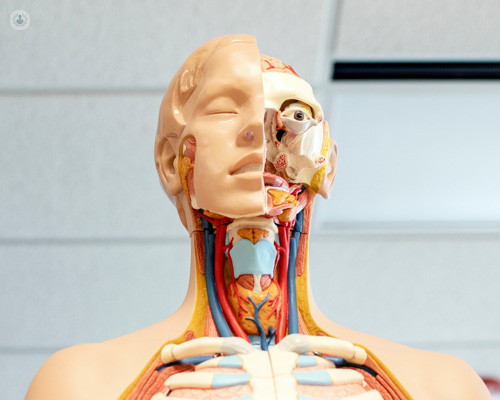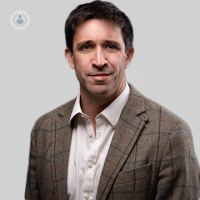Internal and external neck lumps: do I need to worry?
Written in association with:Neck lumps may be external or internal, and may be painless. Highly trained and experienced consultant ear, nose, and throat (ENT) surgeon Professor Stuart Winter explains what to look for, when to worry, and what to expect if your lumps in the neck need treatment.

What are lumps in the neck?
Lumps in the neck are areas that you can feel. They can arise from the skin and the tissues underneath the skin, occur from your saliva glands, from lymph nodes within the neck, as well as endocrine glands, such as the thyroid. It's really important to get these checked out if they're persistent. Swellings from particularly lymph glands can occur in response to infection and they usually settle after a few days, but persistent lumps causing concern need to be examined by a clinician. Quite often, your doctor can reassure you of the underlying cause for this at the first visit. They'll take account of where the lump is, how it feels, how it's behaving, as well as other clinical factors.
What causes neck lumps?
Lumps in the neck can come from a wide variety of sources. You can get them arising in the skin itself, and the area of the tissue just underneath the skin can also generate lumps. We've got saliva glands just under the jaw and in front of the ear which can get blocked and swollen so that you can feel them. Your thyroid gland located lower down in your neck can get swollen and enlarged. There are a large number of lymph nodes on both sides of the neck. Those lymph nodes can swell in response to local and general infection, inflammation, and, very rarely, due to cancer.
There are a few situations in which you're born with the ability to form lumps, even in later life. There's something called a thyroglossal cyst, which can occur in the front of the neck and cystic swellings in the side of the neck can also occur. On occasions, particularly in adults, there is a risk that a lump in the neck can represent a cancer, which is one reason why it's important to get it checked out by a doctor if the lump is persistent and you're worried about it.
A hoarse voice, for example, is quite common and people can often get it if they use their voice a lot or shout causing trauma to the voice box. If they remain hoarse for more than six weeks, they often need investigation, as it impairs the ability to talk, perform, and function normally. While most hoarse voices have no underlying problems on the vocal cords, nodules, polyps, and on a rare occasion, cancer can be associated with a hoarse voice.
When should you see a doctor and what is expected?
As an adult with a swelling in the neck that comes and goes over a couple of days doesn't need any investigation in most cases. If it disappears of its own accord, then it's typically nothing to worry about. In situations where the swelling persists or it's causing local irritation or problems, then it certainly needs to be checked out. Indeed, a painless lump in the neck also needs to be examined by a doctor, particularly if it's there for longer than a couple of weeks.
When you see your doctor with a lump in the neck, the first thing done is take a history. They will focus on:
- How long it has been there, whether it comes up and goes down
- What other symptoms it’s causing
- Any changes over the skin
- How you’re feeling in general, if you’re feeling unwell
- If you’ve lost any weight
- Any history of infections, i.e. tonsilitis
- Any history of previous neck lumps
- Past medical history that can cause lumps
- Current medication being taken
- Lifestyle factors, i.e. smoking and alcohol consumption
After that, they will use the information to hone in their questions.
- Have you been abroad?
- Have you come into any contact with anybody with infections?
- Have you had any sweats at night?
- Are you able to swallow, has your voice changed?
Next, they'll want to examine your neck. Usually, the doctor will stand behind you to examine the lump, looking at where it is, does it move, how it feels, the consistency of it, and trying to define exactly where it's arisen from.
Most ENT surgeons will need to perform a nasal endoscopy or stroboscopy. This is a small painless camera that's passed through your nose to look at the back of your nose, your tongue, your voice box, and the areas of your pharynx. It's really important that it’s done, as on occasions lumps can be associated with problems inside. Certainly, infections can be seen, and on occasions, cancers can also be detected.
After the examination, the doctor will look to see whether you need any further investigations. Occasionally, blood tests can be very useful. There are different sorts of scans that may be needed, such as ultrasound, CT scan, and MRI scan. These scans can be incredibly useful at defining where the lump is arising from and giving a lot of detail about where it's coming from. Ultimately, if your doctor is concerned about the lump, they'll need to try to understand what that lump is. Sometimes, a slightly big needle or even removing the lump itself may be needed to test it. However, the scans and other tests already may provide a huge amount of information and lead the doctor to understand what's going on. Once the cause is known using the appropriate set of investigations done early in the process, then treatment can be directed.
What is the treatment for lumps in the neck?
Treating lumps in the neck really depends on understanding what has caused that swelling. In many cases, you can be reassured that no active treatment is needed, and that requires no additional treatment. If the cause of the swelling is an infection, treating that infection may be appropriate. For more specific areas, thyroid problems require investigation and could require a surgery to remove part of the thyroid. Salivary glands swellings may not need any treatment at all, but removing the salivary gland or removing stones or blockages within the gland can be appropriate. There are a variety of treatments for an enlarged lymph node, depending on the underlying cause. Skin problems need assessment by a dermatologist. On occasion, surgery and radiotherapy for swelling in the neck can be used.
If you have lumps in the neck and would like to have them examined, you can go to Professor Stuart Winter's Top Doctors profile and schedule a visit.


